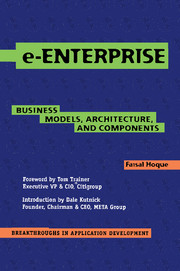Book contents
- Frontmatter
- About the Author
- Contents
- Dedication
- Foreword
- Acknowledgments
- Introduction
- PART 1 The e-Enterprise
- PART 2 Business and Application Models
- PART 3 e-Enterprise Methodology and Architecture
- Chapter 5 Building e-Enterprises
- Chapter 6 e-Enterprise Architecture
- PART 4 Enabling Components
- Afterword: Who Will Be the Great e-Enterprises?
- References
- Index
Chapter 5 - Building e-Enterprises
Published online by Cambridge University Press: 20 May 2010
- Frontmatter
- About the Author
- Contents
- Dedication
- Foreword
- Acknowledgments
- Introduction
- PART 1 The e-Enterprise
- PART 2 Business and Application Models
- PART 3 e-Enterprise Methodology and Architecture
- Chapter 5 Building e-Enterprises
- Chapter 6 e-Enterprise Architecture
- PART 4 Enabling Components
- Afterword: Who Will Be the Great e-Enterprises?
- References
- Index
Summary
E-TRANSFORMATION
The idea of clicks and mortar… suggests that the successful companies in the Internet Economy will be those that do everything well. They'll offer great products at low prices, great service, perfectly targeted marketing, friendly Web sites, beautiful retail spaces, flawless delivery, and so forth… In a clicks and mortar world, you have to do everything, do it fast, and do it right.
—David Pottruck, co-CEO of Charles SchwabIn Chapter 1, I discussed how the Net is bringing about a fundamental change in the way corporations do business. For established “bricks-and-mortar” corporations, the Web was initially an after thought, a place for posting static product information and accepting credit card numbers and shipping addresses to make purchases. We called this “e-Commerce.”
In its second iteration business on the Net became more complex and specialized. Corporations began to appreciate the value of doing businesses with other enterprises, and to implement specialty business-to-business (B-to-B) e-Applications such as Maintenance, Repair, and Operations (MRO) procurement to automate simple online processes. On the business-to-consumer (B-to-C) side, retailers recognized the value of personalized content and dynamic product information. Online marketplaces became more interactive and efficient. “Bricks and mortar” had become “point and click.” Because this stage was about more than simple transactions, we labeled it “e-Business.”
Most companies have embraced e-Commerce by now. Some have taken halting steps toward e-Business. However, I predicted that another stage was coming, where corporations would recognize the Net for its true value: not a new distribution channel or customer touch-point, but a strategic tool that touches every aspect of the enterprise—both on the Net and in the real world, through process engineering, improvement, and integration.
- Type
- Chapter
- Information
- e-EnterpriseBusiness Models, Architecture, and Components, pp. 139 - 172Publisher: Cambridge University PressPrint publication year: 2000
- 1
- Cited by



